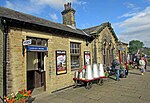Lees Moor Tunnel
Rail transport in West YorkshireRailway tunnels in EnglandTransport in West YorkshireTunnels in West YorkshireUse British English from February 2016

Lees Moor Tunnel is an abandoned tunnel on the former Great Northern Railway line between Queensbury and Keighley in West Yorkshire, England. The former dual track tunnel is just north of the village of Cullingworth in West Yorkshire and when built was 1,533 yards (1,402 m) long. Due to the pitch black inside and the squealing of the wheels on the 1 in 50 radius curve, drivers nicknamed it the 'Hell Hole'. After closure to passengers, the tunnel was used in experiments involving the effects of smoke inhalation and cancer.
Excerpt from the Wikipedia article Lees Moor Tunnel (License: CC BY-SA 3.0, Authors, Images).Lees Moor Tunnel
Bingley Road, Bradford Cross Roads
Geographical coordinates (GPS) Address Nearby Places Show on map
Geographical coordinates (GPS)
| Latitude | Longitude |
|---|---|
| N 53.836638888889 ° | E -1.9255555555556 ° |
Address
Bingley Road
Bingley Road
BD21 5QE Bradford, Cross Roads
England, United Kingdom
Open on Google Maps











